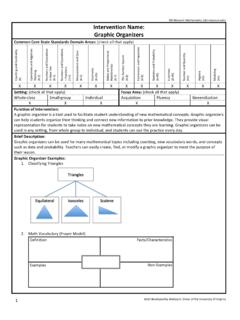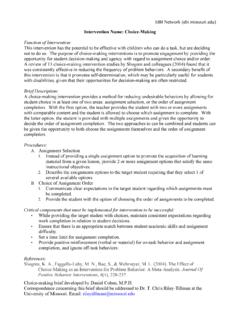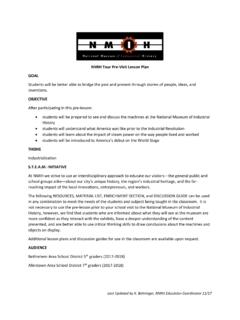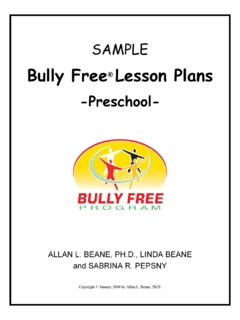Transcription of Vocabulary Lesson Classroom Ideas - University of Missouri
1 Compiled by Rebecca S. Martinez, Page 1 of 4 20 Vocabulary Lesson Ideas 1. Anything Goes (Richek & McTague, 2008) This is used as a quick review of words that moves students from hesitation to rapid use. Teacher presents students with a list of words (board, overhead or word wall). Teacher or student points to a word and asks: i. What part of speech is _____? ii. What is the definition of _____? iii. Give another form of _____. iv. Spell (a derivative or inflected form of) _____. v. Use _____ in a sentence. vi. Use _____ and _____ in a sentence. vii. What do _____ and _____ have in common? viii. Find two words that have to do with _____.
2 Ix. Find a (the) root (or prefix, suffix) in _____. 2. Brain Power Words (Richek & McTague, 2008) Ask small groups of students to preview sections of a text and identify difficult words. For long chapters, assign different sections to different groups. Students place a Post-it next to the words in the text they identify as potentially difficult. After identifying the words, the group goes back and uses context clues to hypothesize what the words might mean. i. Clues of substitution: A known word would make sense in the context and is probably a good definition. ii. Clues of definition: The word is defined in the text (many textbooks do this).
3 Iii. Clues of opposition: Words not, unlike etc. are excellent clues to what a word is not and thus help define the words. After Brain Power Words list is identified and definitions sought, the students check their work with the teacher. 3. Concept Cube (Montgomery, 2008) Students receive six-square pattern on tagboard that can be folded up and taped into a three-dimensional cube, which will be 4 on each side. Before folding, students write clearly in each square following directions below. Each student is given one challenging Vocabulary word from a recent reading and asked to: i. Write the assigned Vocabulary word in one square. ii.
4 Write a synonym (word or phrase) in another square. iii. Write an antonym (word or phrase) in another square. iv. Write a category or categories it could belong to. v. Write the essential characteristics of the concept of this word. vi. Give one example. Cut, fold, and tape the cube. Roll the cube and read what comes up on the top ; the student must tell the relationship of that word or phrase to the original word. Teachers scaffold as necessary. After students know their own cube without any errors, they exchange with a peer. 4. Concept Definition Map A graphic organizer that has students draw an illustration representing their text to help them think about it in terms of definitions, related concepts, and examples.
5 Helps them to learn new Vocabulary and concepts in a more holistic way. May be used for a single concept or for an entire passage. Compiled by Rebecca S. Martinez, Page 2 of 4 5. Connect Two (Richek & McTague, 2008) Game where two lists of words are put on a blackboard or overhead projector. Students are asked to make connections between a word on the first list and a word on the second list and they must explain the reason for the connection that they made. 6. Dictionary games (Reiss, 2008) Set up timed competitions. Group students by tables or set one-half of the room against the other. Gamelike structure motivates and involves students.
6 7. Find that Word (Richek & McTague, 2008) Students are asked to record words they are studying when they encounter them in reading and speech. This enables students to see the words in different contexts and deepens their Vocabulary knowledge. Teacher gives students a list of target words. Students are to write the sentence in which the words appears (students can be given strips of paper). One way to add interest is to see how many a class can collect! Devote a few minutes each week to reading the sentences then post them. Points can be awarded for: i. 1 point Student saw or heard the word in speech, print or the media. ii.
7 2 points Student used the word in speech (peer wrote the sentence). iii. 3 points Student used the word in writing. Activity takes a minimum of instructional time, yet encourages notice and use of Vocabulary words. 8. Language Detectives(Reiss, 2008) Identify Language Detectives. ELLs or Spanish speakers who find academic words with Spanish cognates. What it does: decreases language load so ELLs can access the content. 9. Pair-Define-Explain (Reiss, 2008) Teach Vocabulary by sprinkling your instruction with interesting words and phrases. Pair the word or phrase with high-frequency synonym, definition, explanation or visual depiction.
8 Repeat them frequently always pairing with the explanatory source. He committed an egregious error a very bad mistake. The liquid becomes effervescent bubbly, full of bubbles when we stir it. The Pilgrims embarked on a long journey. They started on a long trip. She was motivated by vengeance she wanted to punish him, sort of get back or get even with him. 10. Personal Dictionaries (Reiss, 2008) Have Students Develop a Personal Dictionary. You or students select organizing principle: Subject specific Alphabetical General/technical Social/academic English only or bilingual; Can include native language translations; Antonyms and synonyms 11.
9 Semantic Maps ( ) A Semantic Map is one type of graphic organizer. It helps students visually organize and graphically show the relationship between one piece of information and another. Researchers have identified this strategy as an excellent technique for increasing Vocabulary and improving reading comprehension. As a prereading Compiled by Rebecca S. Martinez, Page 3 of 4 activity, Semantic Mapping can be used to activate prior knowledge and to introduce key Vocabulary words. As a postreading activity, words, categories, and new concepts can be added to the original maps to enhance understanding. If the strategy is used during both prereading and postreading instruction, it is suggested that different colored pens be used as Ideas are recorded.
10 O The teacher decides on a topic for instruction and the new words that are important to be taught. The topic or concept is briefly introduced, and a key word is written on the chalkboard, overhead transparency, or chart paper. o Students are asked to think of other words that come to mind when they read the key word. It is also appropriate for the students to write down a list of these words to be shared with the class. o The students share their recorded words. If any of the teacher's "new words" are not suggested, the teacher presents them for discussion. o After the list of words is completed, the words are grouped by category. Students discuss why certain words go together.











